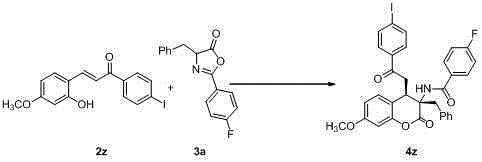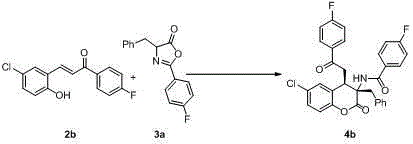Synthesis method of chiral 3,4-dihydrocoumarin derivative compound
A technology of dihydrocoumarin and synthesis method, which is applied in the field of catalytic synthesis of chiral 3,4-dihydrocoumarin derivative compounds, can solve the problems of high cost, difficult synthesis of substrates and catalysis, and achieves easy operation. , easy to handle, and excellent corresponding to the effect of selectivity
- Summary
- Abstract
- Description
- Claims
- Application Information
AI Technical Summary
Problems solved by technology
Method used
Image
Examples
Embodiment 1
[0028]
[0029] Add quininethiourea (2.8 mg, 0.005 mmol) successively to the reaction flask, and 2a (25.9 mg, 0.1 mmol), 3a (53.8 mg, 0.2 mmol), 4? Molecular sieves (150 mg), stirred, added 1.5 mL m-xylene, reacted at minus 5 degrees Celsius for 12 hours, and the reaction system was subjected to simple column chromatography (eluent was dichloro Methane: Petroleum ether = 2:1) to get the target product 4a (15.9 mg), white solid, 60% yield, >20 / 1 dr, 80% ee.
[0030] Add quininethiourea (5.6 mg, 0.01 mmol) successively to the reaction flask, and 2a (25.9 mg, 0.1 mmol), 3a (53.8 mg, 0.2 mmol), 4? Molecular sieves (150 mg), stirred, added 1.5 mL m-xylene, reacted at minus 5 degrees Celsius for 12 hours, and the reaction system was subjected to simple column chromatography (eluent was dichloro Methane: Petroleum ether = 2:1) to get the target product 4a (29.0 mg), white solid, 75% yield, >20 / 1 dr, 79% ee.
[0031] Add quininethiourea (11.2 mg, 0.02 mmol) sequentially...
Embodiment 2
[0035]
[0036] Add quininethiourea (11.2 mg, 0.02 mmol) sequentially to the reaction flask, and 2b (27.7 mg, 0.1 mmol), 3a (26.9 mg, 0.1 mmol), 4? Molecular sieves (150 mg), add 1.5 mL m-xylene, react at minus 5 degrees Celsius for 12 hours, and the reaction system is subjected to simple column chromatography (eluent is dichloromethane: Petroleum ether=2:1) to get the target product 4b (21.8 mg), white solid, 65% yield, >20 / 1 dr, 91% ee.
[0037] Add quininethiourea (11.2 mg, 0.02 mmol) sequentially to the reaction flask, and 2b (27.7 mg, 0.1 mmol), 3a (40.3 mg, 0.15 mmol), 4? Molecular sieves (150 mg), add 1.5 mL m-xylene, react at minus 5 degrees Celsius for 12 hours, and the reaction system is passed through simple column chromatography (eluent is dichloromethane: Petroleum ether=2:1) to get the target product 4b (32.7 mg), white solid, 78% yield, >20 / 1 dr, 90% ee.
[0038] Add quininethiourea (11.2 mg, 0.02 mmol) sequentially to the reaction flask, and ...
Embodiment 3
[0042]
[0043] Add quinine thiourea (11.2 mg, 0.02 mmol) successively to the reaction flask, and 2c (29.3 mg, 0.1 mmol), 3a (53.8 mg, 0.2 mmol), 4? Molecular sieves (150mg), add 1.5 mL m-xylene, react at minus 5 degrees Celsius for 12 hours, and the reaction system is passed through simple column chromatography (eluent is dichloromethane: petroleum ether=2:1) to get the target product 4c (52.4 mg), white solid, 95% yield, >20 / 1 dr, 92% ee.
[0044] Add quininethiourea (11.2 mg, 0.02 mmol) sequentially to the reaction flask, and 2c (29.3 mg, 0.1 mmol), 3a (53.8 mg, 0.2 mmol), add 1.5 mL of m-xylene, react at minus 10 degrees Celsius for 12 hours, and the reaction system is subjected to simple column chromatography (eluent is dichloromethane:petroleum ether=2:1) that is The target product can be obtained 4c (27.6 mg), white solid, 72% yield, >20 / 1 dr, 96% ee.
[0045] to product 4c Analyzed, the results are as follows: Determination by HPLC [Daicel Chiralcel...
PUM
 Login to View More
Login to View More Abstract
Description
Claims
Application Information
 Login to View More
Login to View More - R&D
- Intellectual Property
- Life Sciences
- Materials
- Tech Scout
- Unparalleled Data Quality
- Higher Quality Content
- 60% Fewer Hallucinations
Browse by: Latest US Patents, China's latest patents, Technical Efficacy Thesaurus, Application Domain, Technology Topic, Popular Technical Reports.
© 2025 PatSnap. All rights reserved.Legal|Privacy policy|Modern Slavery Act Transparency Statement|Sitemap|About US| Contact US: help@patsnap.com



